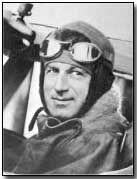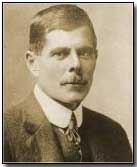The War in the Air - The Missionaries of Bombing
 In September of 1918 the American general
Pershing commanded the first
US led attack of the war against the salient of St Mihiel not far from
Verdun.
In September of 1918 the American general
Pershing commanded the first
US led attack of the war against the salient of St Mihiel not far from
Verdun.
His Chief of Air Service at this battle was Billy Mitchell. Mitchell was an early enthusiast of aviation and had headed the aviation section of the US Signal Corps. In 1917, before America's entry into the war, he had been sent to Europe as an observer. During this period he was befriended and influenced by Hugh Trenchard.
For the upcoming battle Mitchell gathered together the largest concentration of aircraft of the entire war. He had over 1400 planes at his command. More than 300 of them were day bombers and almost 100 were night bombers. About 40 percent of this force were American pilots, the rest being made up by French, British and Italians.
Mitchell's plans were thwarted, however, as the crucial first two days of the battle were fought in bad weather, preventing the kind of mass air attack that Mitchell had intended.
In the immediate aftermath of the war Hugh Trenchard, Billy Mitchell and the Italian Giulio Douhet (who had commanded Italy's first aviation unit from 1912 to 1915) all published influential papers pushing the idea that the bomber would change warfare forever.
What would decide future conflicts, they claimed, was not the forces on the ground but the forces in the air. Trenchard remarked that while there had been only seven bombing raids against Trier, there had been over one hundred alerts, with the accompanying affect on morale and production. Given a large bomber force, Trenchard and the others argued, the effect would be war winning. Future wars would be won by strategic bombing aimed at destroying the enemy's industrial centres and breaking civilian morale.
 Trenchard
commanded the RAF for ten years, from 1919 onwards, and his influence lasted
well beyond that. Billy Mitchell clashed with his superiors, was court
martialed and resigned, but nevertheless he deeply affected American
military thinking.
Trenchard
commanded the RAF for ten years, from 1919 onwards, and his influence lasted
well beyond that. Billy Mitchell clashed with his superiors, was court
martialed and resigned, but nevertheless he deeply affected American
military thinking.
In the Second World War the Germans had superb tactical bombers, and used them as a weapon of terror against civilian targets. The British and Americans, however, were the only combatants who flew four engined heavy bombers. They were the only ones would could mount a sustained strategic bombing campaign, and they succeeded in severely disrupting their enemy's production capabilities.
The table below lists the important bomber types used in the war. It is sorted by the size of the bomb load.
| Airplane | Country | Bomb Load (kg) | Bomb Load (lb) | No. of Engines |
|---|---|---|---|---|
| BE2c | Britain | 102 | 224 | 1 |
| Sopwith 1½ Strutter | Britain | 118 | 260 | 1 |
| Voisin III | France | 150 | 330 | 1 |
| DH4 | Britain | 210 | 460 | 1 |
| Breguet 14 | France | 260 | 570 | 1 |
| Caproni CA32 | Italy | 450 | 1,000 | 3 |
| Gotha | Germany | 500 | 1,100 | 2 |
| Ilya Murometz | Russia | 800 | 1,760 | 4 |
| O/400 | Britain | 910 | 2,000 | 2 |
| Caproni CA42 | Italy | 1,450 | 3,197 | 3 |
| Giant | Germany | 2,000 | 4,400 | 4 |
Article contributed by Ari Unikoski
Photographs courtesy of Photos of the Great War website
Next - Ground Attack
"Hun" was a slang term used by the allies, to describe the Germans. "Boche" was another.
- Did you know?
